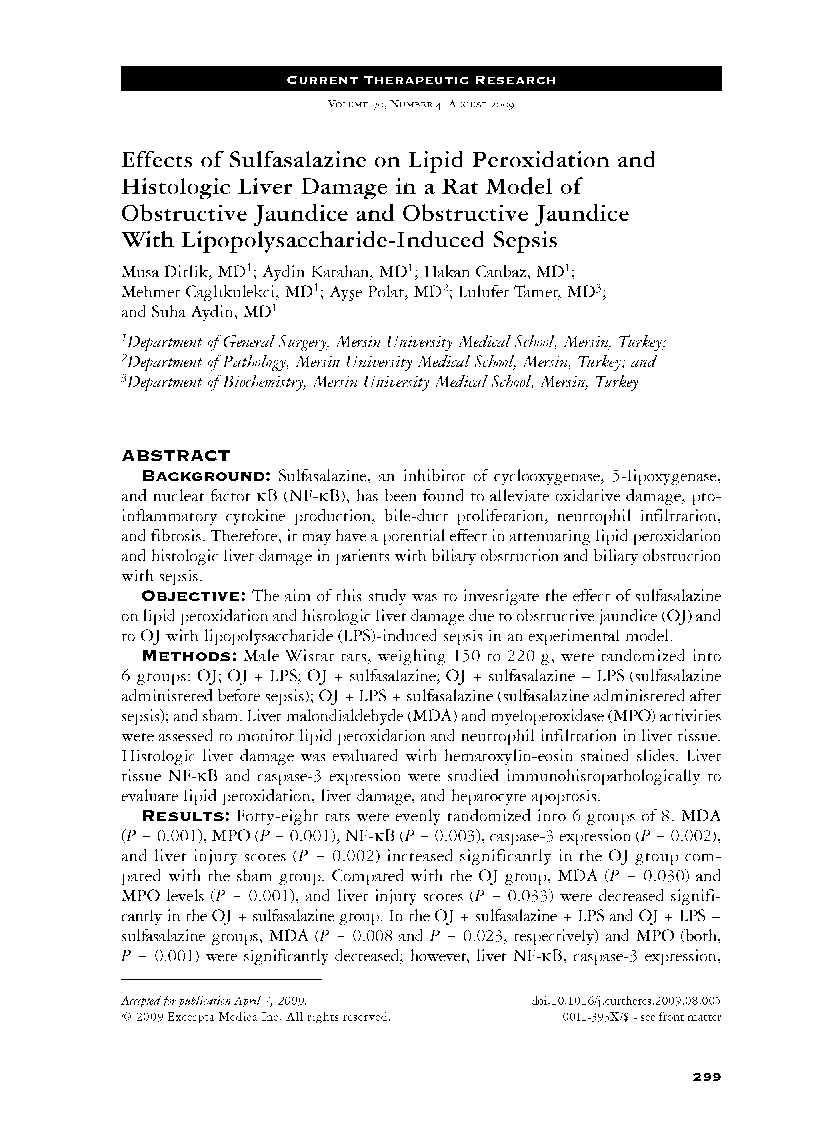| کد مقاله | کد نشریه | سال انتشار | مقاله انگلیسی | نسخه تمام متن |
|---|---|---|---|---|
| 4196930 | 1278726 | 2009 | 17 صفحه PDF | دانلود رایگان |

Background: Sulfasalazine, an inhibitor of cyclooxygenase, 5-lipoxygenase, and nuclear factor κB (NF-κB), has been found to alleviate oxidative damage, proinflammatory cytokine production, bile-duct proliferation, neutrophil infiltration, and fibrosis. Therefore, it may have a potential effect in attenuating lipid peroxidation and histologic liver damage in patients with biliary obstruction and biliary obstruction with sepsis.Objective: The aim of this study was to investigate the effect of sulfasalazine on lipid peroxidation and histologic liver damage due to obstructive jaundice (OJ) and to OJ with lipopolysaccharide (LPS)-induced sepsis in an experimental model.Methods: Male Wistar rats, weighing 150 to 220 g, were randomized into 6 groups: OJ; OJ + LPS; OJ + sulfasalazine; OJ + sulfasalazine + LPS (sulfasalazine administered before sepsis); OJ + LPS + sulfasalazine (sulfasalazine administered after sepsis); and sham. Liver malondialdehyde (MDA) and myeloperoxidase (MPO) activities were assessed to monitor lipid peroxidation and neutrophil infiltration in liver tissue. Histologic liver damage was evaluated with hematoxylin-eosin stained slides. Liver tissue NF-κB and caspase-3 expression were studied immunohistopathologically to evaluate lipid peroxidation, liver damage, and hepatocyte apoptosis.Results: Forty-eight rats were evenly randomized into 6 groups of 8. MDA (P = 0.001), MPO (P = 0.001), NF-κB (P = 0.003), caspase-3 expression (P = 0.002), and liver injury scores (P = 0.002) increased significantly in the OJ group compared with the sham group. Compared with the OJ group, MDA (P = 0.030) and MPO levels (P = 0.001), and liver injury scores (P = 0.033) were decreased significantly in the OJ + sulfasalazine group. In the OJ + sulfasalazine + LPS and OJ + LPS + sulfasalazine groups, MDA (P = 0.008 and P = 0.023, respectively) and MPO (both, P = 0.001) were significantly decreased; however, liver NF-κB, caspase-3 expression, and liver injury scores were not significantly different compared with the OJ + LPS group. There was no significant difference between the OJ + LPS + sulfasalazine and OJ + sulfasalazine + LPS groups in regard to all end points when comparing the effects of sulfasalazine administered before or after sepsis.Conclusions: Sulfasalazine was associated with decreased neutrophil accumulation and lipid peroxidation in these rats with OJ. Administration of sulfasalazine before or after LPS-induced sepsis was associated with a reduction in lipid peroxidation and neutrophil accumulation; however, it did not attenuate histologic liver damage. There was no difference between the findings when sulfasalazine was administered before or after sepsis in OJ.
Journal: Current Therapeutic Research - Volume 70, Issue 4, August 2009, Pages 299-315